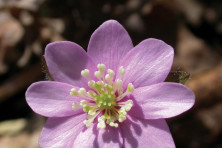Thank Ants for Wildflowers
- Share
- Tweet
- Pin
- Share

With our forests spangled with trillium, and parks and woodlands vibrant with spring wildflowers, May is a special time in Door County. But it’s mystifying, too, because often, when we drive between two apparently identical mature woodlands, we notice that one is teeming with beautiful flowers while the other has none. Why don’t wildflowers spread from one forest to another?
It depends on how the seeds are dispersed. If seeds are spread by wind, the flowers can turn up almost anywhere (think dandelions and milkweed). Plants with berries are often spread by birds or small mammals so they are pretty well distributed. But for plants that are planted by ants, roads can be an obstacle. So can competition.
Flowers planted by ants? Yes, indeed. It’s so common, the process has a name: myrmecochory (mur’ mi coe chory), which means “ant farming.” Understand that there are many, many species of ants and only some of them plant seeds.
Wildflower seeds would not last long if they merely ripened and fell to the forest floor. Those seeds that were not eaten by birds and small mammals would grow into tiny sprouts ill equipped to compete with their parent plants. A young plant has a much better chance at survival if its seed is carried away from the parents. In the case of flowers such as hepatica, bloodroot, anemone, trillium and violets, ants disperse and plant the seeds.
The seeds of these wildflowers are coated with fleshy protuberances filled with oils and sometimes sugars. These delicacies must be irresistible. Consequently, ants haul them into their nests to be consumed or fed to their larvae. The actual seeds have extremely hard shells…much too hard for ants to eat, so the tidy creatures discard the seeds in one of their underground tunnels.
Underground, the seeds will not be eaten by birds, burned by fire, or be shaded and outcompeted by the parent plants, so a year or so after being planted, the wildflower seeds may germinate and begin the long process of reaching maturity and blooming.
Researchers have documented ants lugging seeds as far as 70 yards, but usually, the ants in our woods travel shorter distances. It is unthinkable our forest ants would venture across a road, a plowed field, or even a lawn. Wildflowers can spread by rhizomes, bulbs and runners, but asphalt and mowers halt their spread.
Ecologists are starting to talk more and more about “wildlife corridors,” and when they do, we tend to think of large mammals or migrating birds. But small creatures need wildlife corridors too. Ants and turtles and squirrels need to move between woodlots, because in the process of feeding themselves, these creatures are making our forests sustainable. To help wild creatures help us, we need to work to connect the forest remnants we still have so they – the forests and the wildlife – can continue to flourish.

